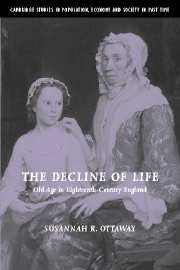Book contents
- Frontmatter
- Contents
- List of figures
- List of tables
- Acknowledgments
- List of abbreviations
- Introduction: Old age in eighteenth-century England: no “golden age of aging”
- 1 Who was “old” in eighteenth-century England?
- 2 The activities of the “helmsman”: self-reliance, work, and community expectations of the elderly
- 3 “The comforts of a private fire-side”
- 4 Independent but not alone: family ties for the elderly
- 5 Community assistance to the aged under the Old Poor Law
- 6 Continuity and change in community assistance to the elderly over the eighteenth century
- 7 Within workhouse walls: indoor relief for the elderly
- Conclusion: Old age as a useful category of historical analysis
- Bibliography
- Index
4 - Independent but not alone: family ties for the elderly
Published online by Cambridge University Press: 15 December 2009
- Frontmatter
- Contents
- List of figures
- List of tables
- Acknowledgments
- List of abbreviations
- Introduction: Old age in eighteenth-century England: no “golden age of aging”
- 1 Who was “old” in eighteenth-century England?
- 2 The activities of the “helmsman”: self-reliance, work, and community expectations of the elderly
- 3 “The comforts of a private fire-side”
- 4 Independent but not alone: family ties for the elderly
- 5 Community assistance to the aged under the Old Poor Law
- 6 Continuity and change in community assistance to the elderly over the eighteenth century
- 7 Within workhouse walls: indoor relief for the elderly
- Conclusion: Old age as a useful category of historical analysis
- Bibliography
- Index
Summary
Although pitched battles have been fought over when, and how, the nuclear, affectionate, individualistic family was formed, there is wide consensus that this was the essential nature of the family by the end of the early modern period. At the same time, it is clear that although uniform characteristics are evident in ideal constructions of family life, there was tremendous variety in regards to individual ability to meet these ideals throughout the period. Moreover, men and women, young and old, rich and poor had very different experiences of life within their family settings. This chapter supports the current conception of the eighteenth-century family as bound by close emotional ties between parents and their children, and it indicates that these expectations were well in place by the beginning of the 1700s, suggesting a high level of continuity over the century. At the same time, however, studying the experiences of older people provides further evidence for the need to take into consideration the different family lives that were constructed around variations in the demographic circumstances and life-stages of individuals.
In particular, for the elderly, and for unmarried individuals, kin beyond the nuclear family played a profoundly important role in the economic and emotional well-being of both men and women. The importance of family ties to older people has proven a contentious issue among historians of aging.
- Type
- Chapter
- Information
- The Decline of LifeOld Age in Eighteenth-Century England, pp. 141 - 172Publisher: Cambridge University PressPrint publication year: 2004

